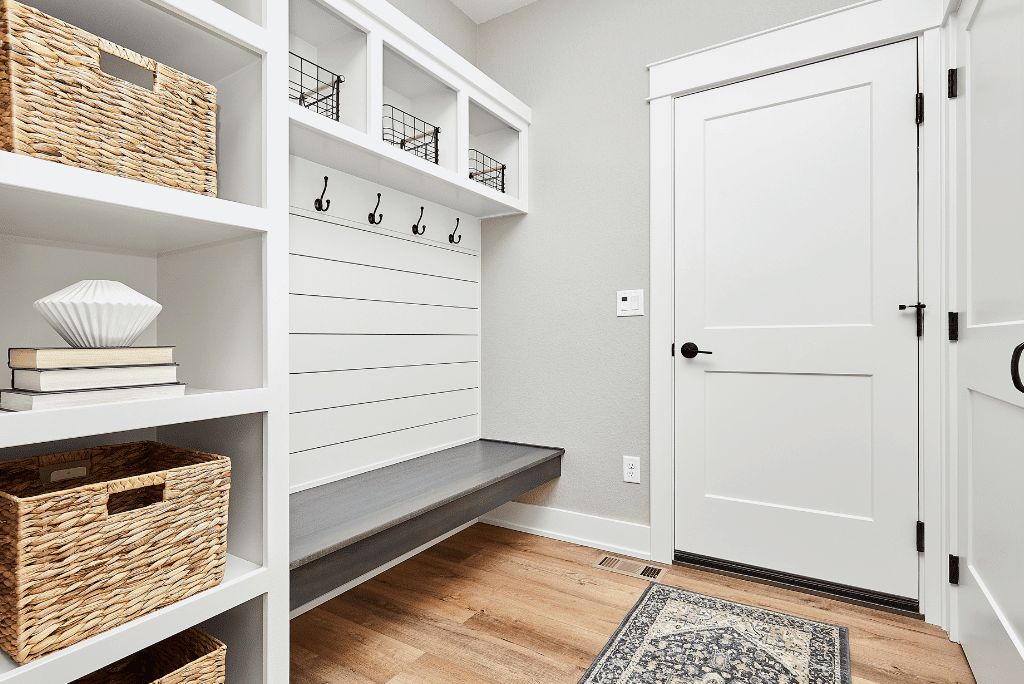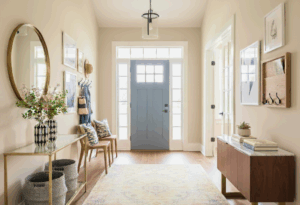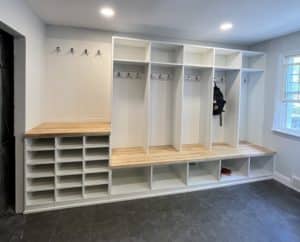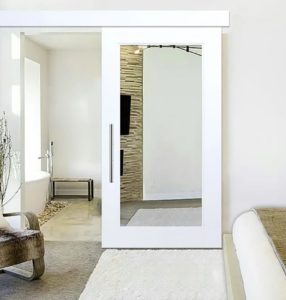A custom mudroom offers practical space to manage life’s daily clutter. Whether you enter through the front door or the garage, mudroom storage can make the difference between a clean home and chaos. Designing built-in closet space that matches your routine helps create order from the moment you walk in. These ideas focus on making the most of your layout, especially when it comes to storage space and functional closet design.
From shoe storage to laundry room overflow, here are 25 custom mudroom ideas that blend structure with simplicity.
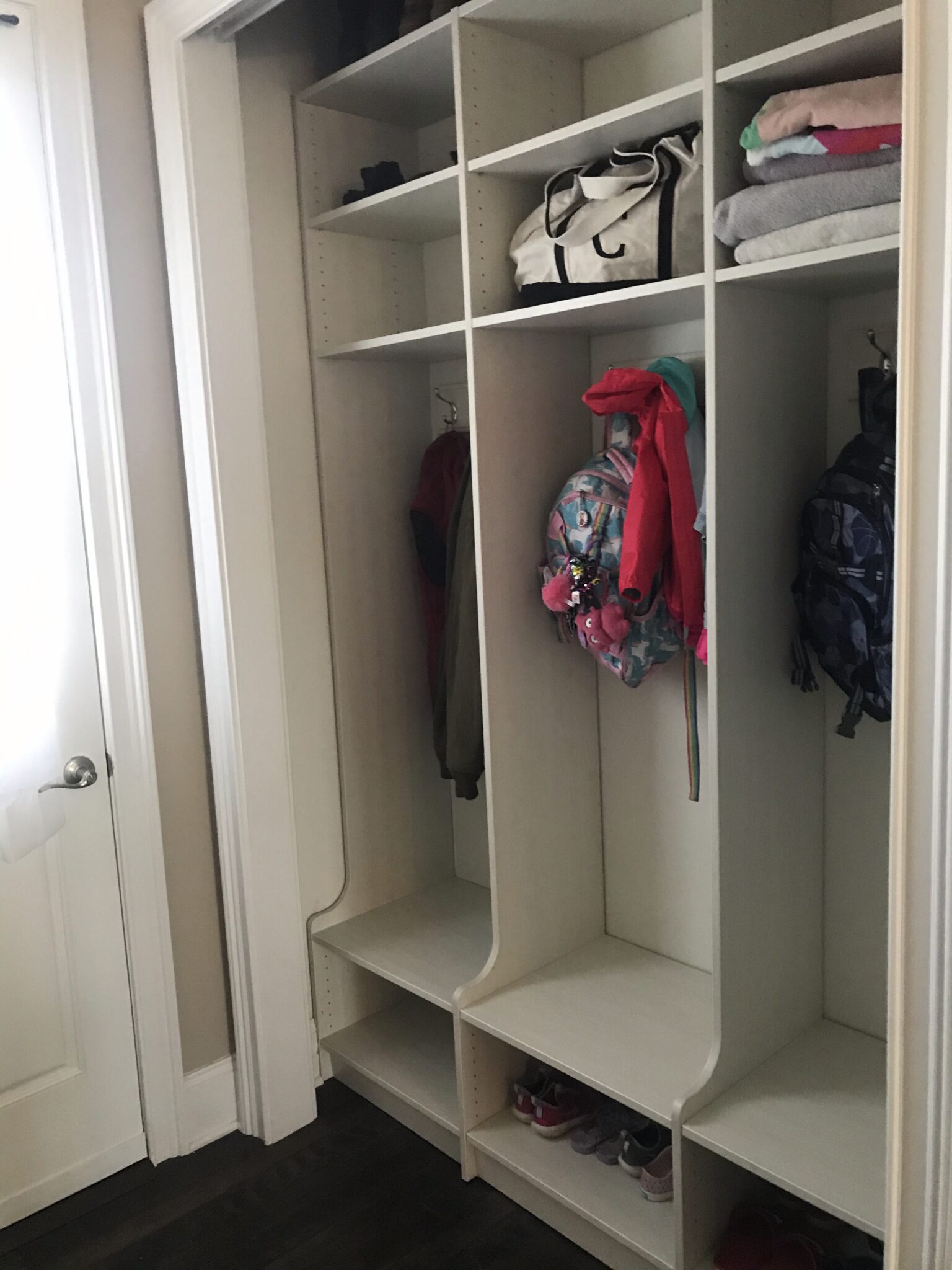
1. Floor-to-Ceiling Mudroom Lockers
Floor-to-ceiling lockers make immediate use of your vertical space. This setup gives each family member a dedicated section for coats, bags, and shoes. Closed doors keep things tidy, while tall interior divisions help organize gear by type or season. It’s a straightforward way to bring structure to a high-traffic zone.
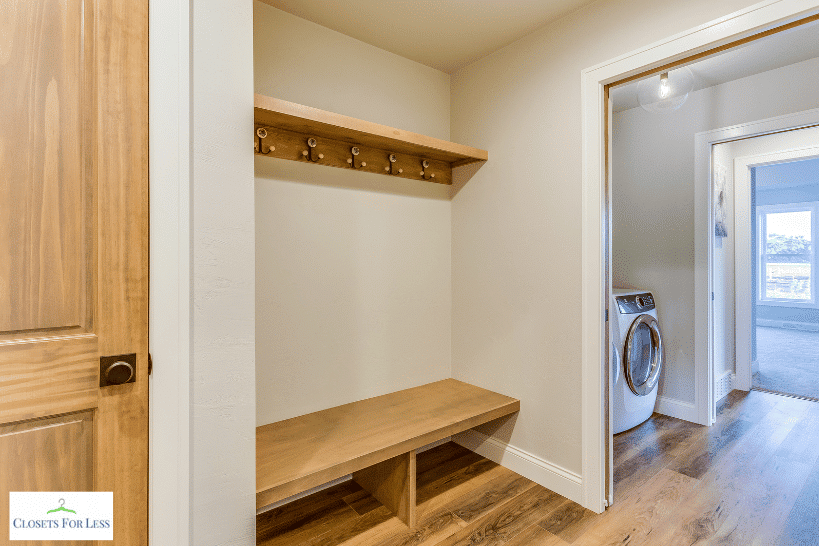
2. Bench Seating With Built-In Storage Below
A bench with lift-up lids or deep drawers underneath adds easy-access storage space without wasting floor area. It fits well beneath hooks or lockers and gives you a place to sit while tying your shoes. Store bulky items like boots or backpacks out of view while keeping them close. This common feature adds comfort and utility in one piece.
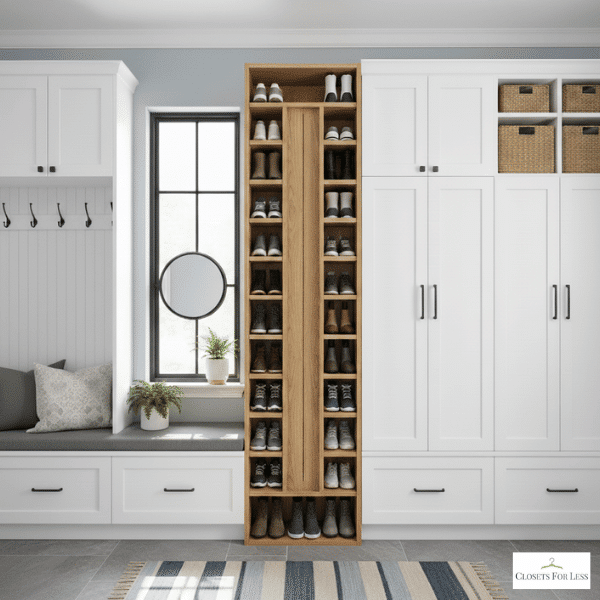
3. Slim Shoe Tower Between Cabinets
A tall, narrow shoe tower helps organize daily footwear in a vertical format. Built-in dividers separate pairs and let shoes dry out naturally. Placed between larger mudroom cabinets, the tower makes use of every available inch. This helps prevent shoes from piling up around the entryway.
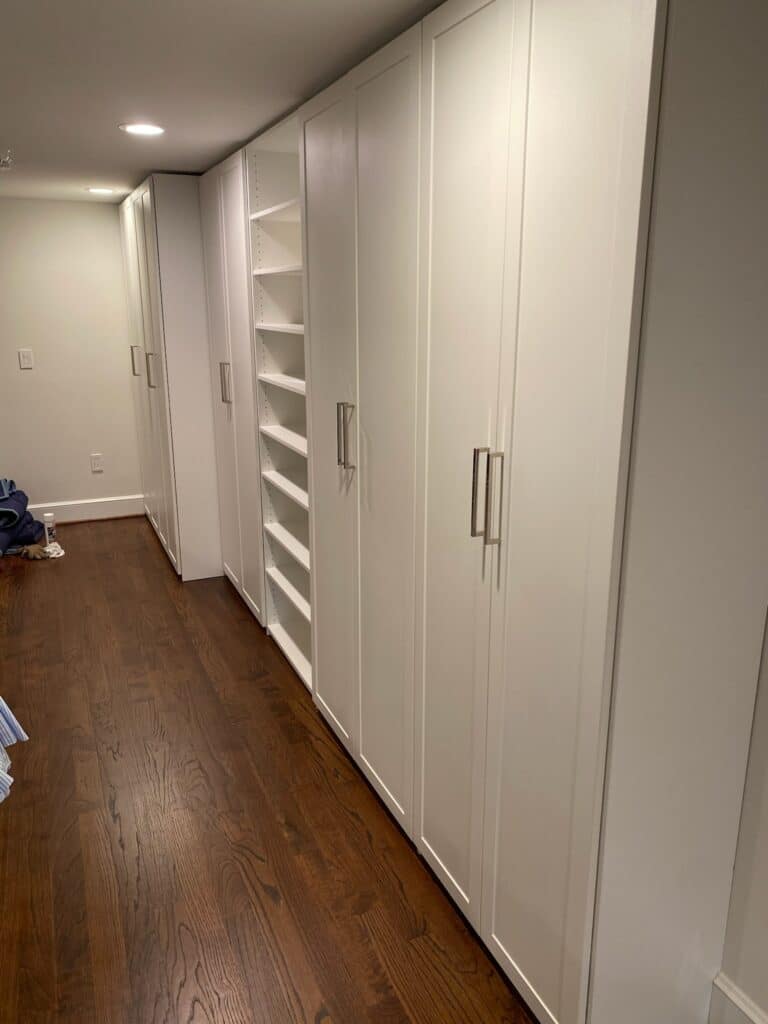
4. Vertical Closet Just for Sports Equipment
Designate a closet section for balls, helmets, bats, and pads. Tall bins or vertical racks work well for oddly shaped sports equipment. A pull-out drawer at the base can collect smaller accessories like shin guards or gloves. This storage system keeps athletic gear out of the living room—and out of the way.
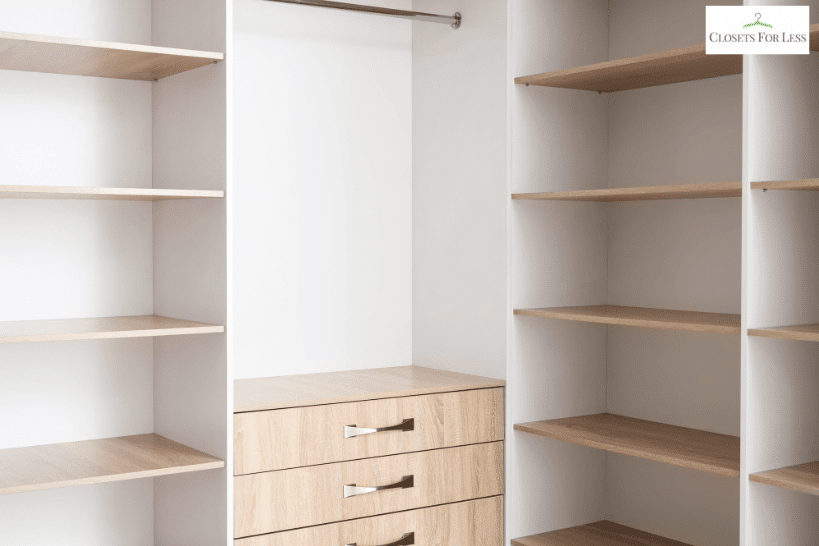
5. Open Shelving for Quick-Grab Items
Install open shelving along one wall for hats, sunglasses, keys, and other everyday carry items. Combine shelves with labeled bins to keep things contained but visible. This style works well above benches or as part of a locker system. It provides quick access without sacrificing organization.
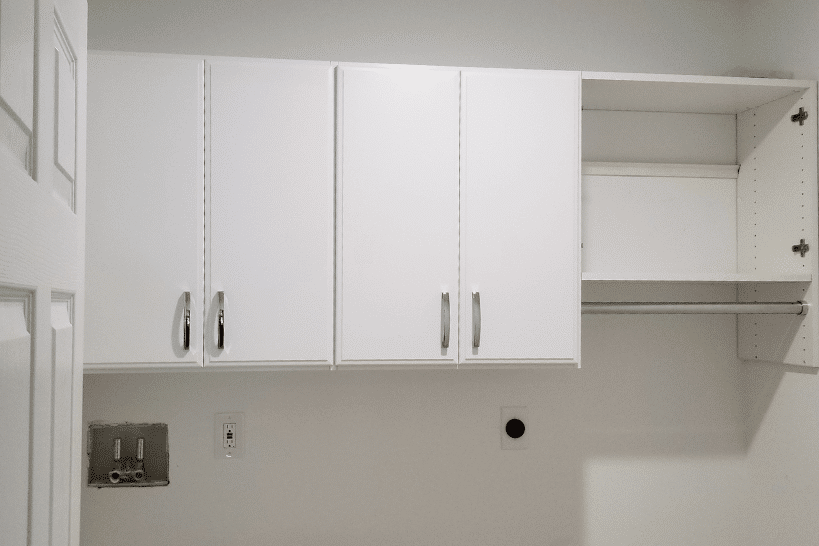
6. Upper Cabinets for Seasonal Storage
Adding cabinets near the ceiling creates space for items you don’t use every day. Store cold-weather gear in summer and beach gear in winter. Closed doors keep dust out, and tall shelves take pressure off floor-level storage. This method adds long-term storage options to your mudroom design.
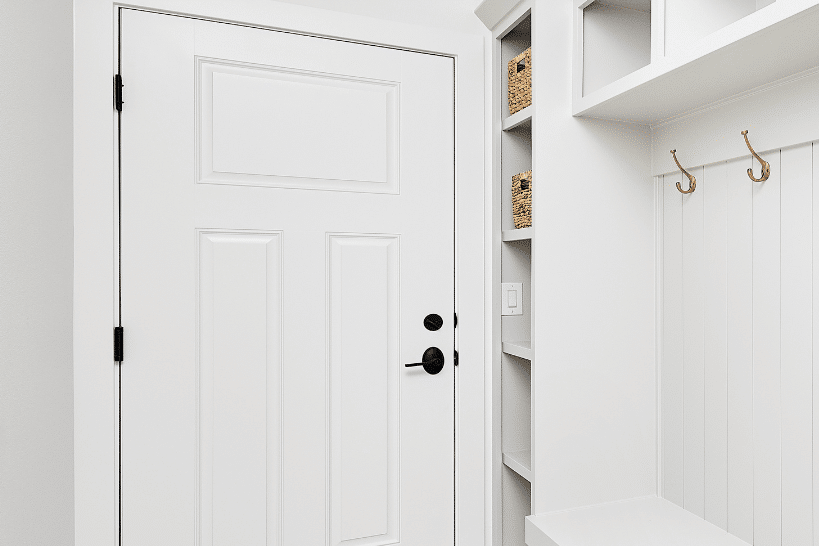
7. Slim Utility Closet Near the Front Door
A shallow utility closet tucked near the front door can house umbrellas, a broom, or delivery packages. Even 6–8 inches of depth can hold narrow items upright. A narrow pull-out rack makes small footprints more functional. Spaces like this often go overlooked but can prove useful.
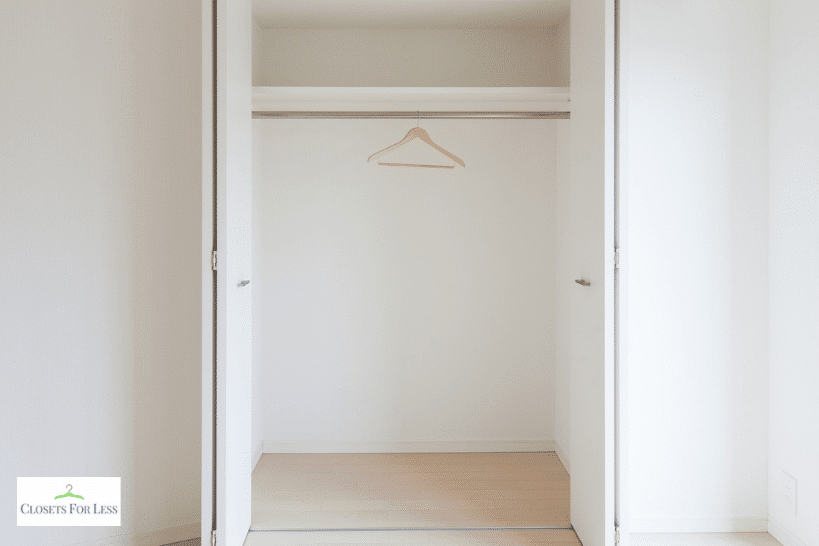
8. Peg Rail Closet Backdrop
Line the interior of a mudroom closet with a peg rail system to create hanging flexibility. Hang jackets, scarves, or dog leashes at different intervals based on the season. Upgrade function with a top shelf and shoe storage underneath. Peg rails keep gear orderly while staying easy to adjust.
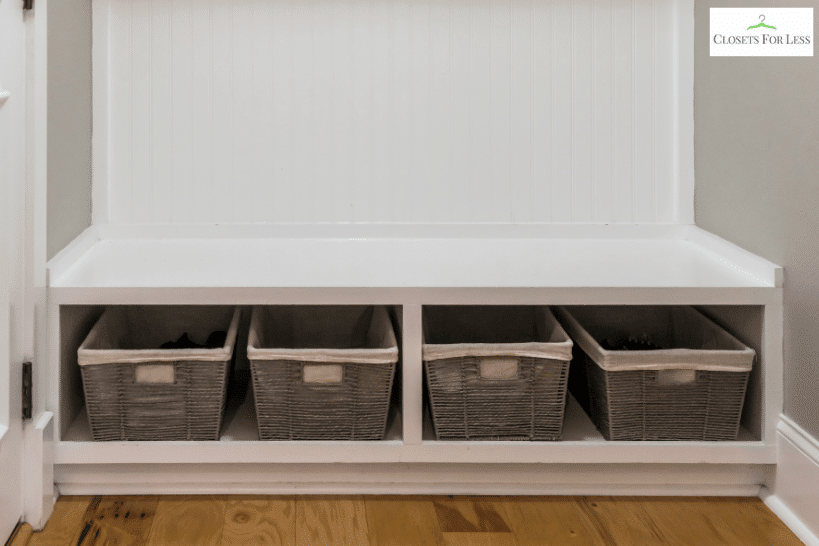
9. Pull-Out Crates Under Built-In Seating
Instead of closed drawers, opt for open pull-out crates or bins under benches. Use them to sort outdoor toys, hats, or gardening tools. The open design encourages quick drop-offs, especially for kids. This mudroom storage style relies more on accessibility than appearance.
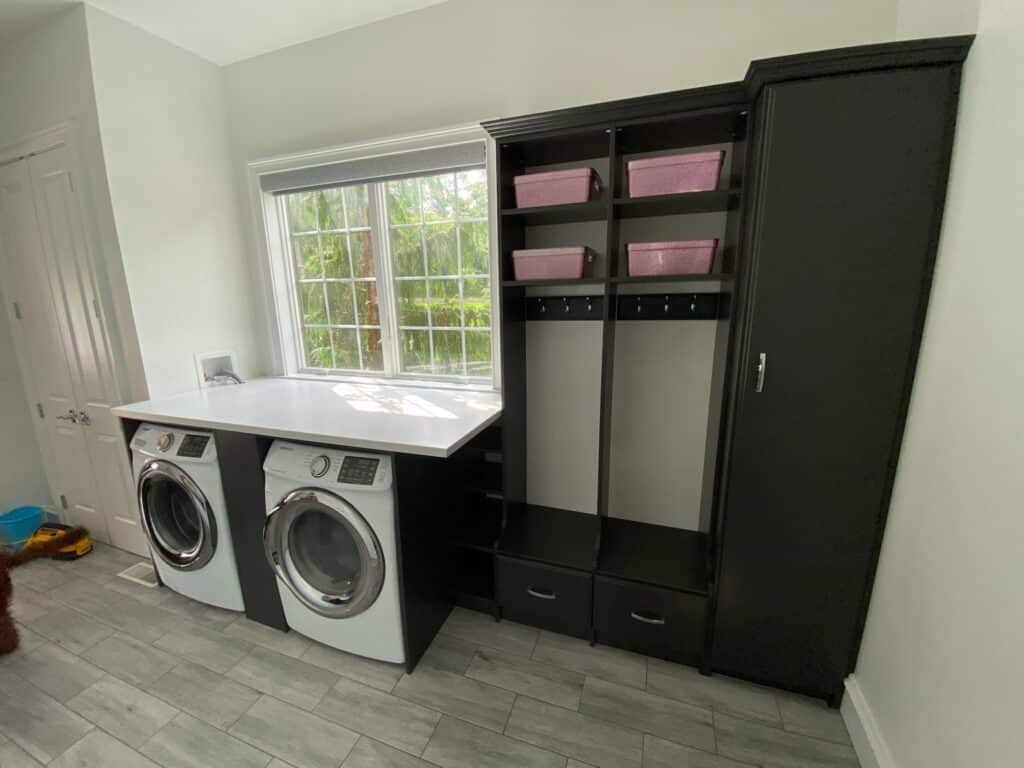
10. Sectioned Cabinet for Laundry Room Overflow
If your mudroom connects to the laundry room, add a pantry-style cabinet for overflow laundry supplies. Organize each shelf by category—paper goods, soaps, sponges—to keep them easy to grab. This setup minimizes back-and-forth between rooms. Closed doors maintain a clean, streamlined look.
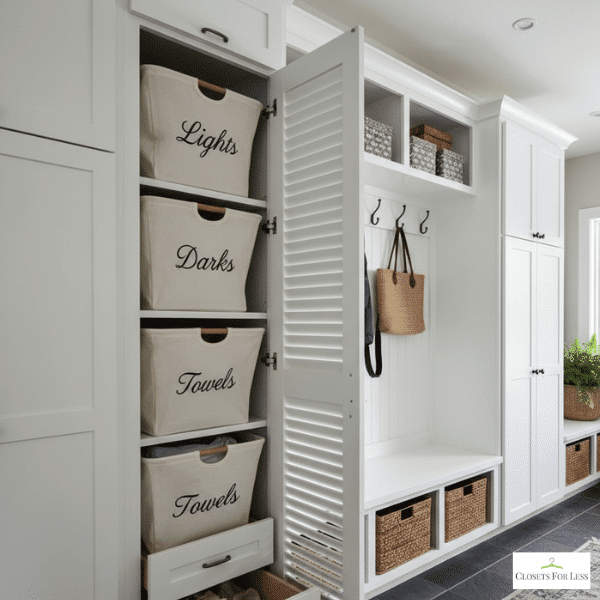
11. Built-In Hamper with Sorting Sections
Set aside part of your mudroom closet for a built-in hamper. Use removable canvas bins to pre-sort laundry into lights, darks, and towels. Having laundry drop-off near the entryway prevents dirty clothes from traveling through the rest of the home. Add a simple door or panel to keep it hidden.
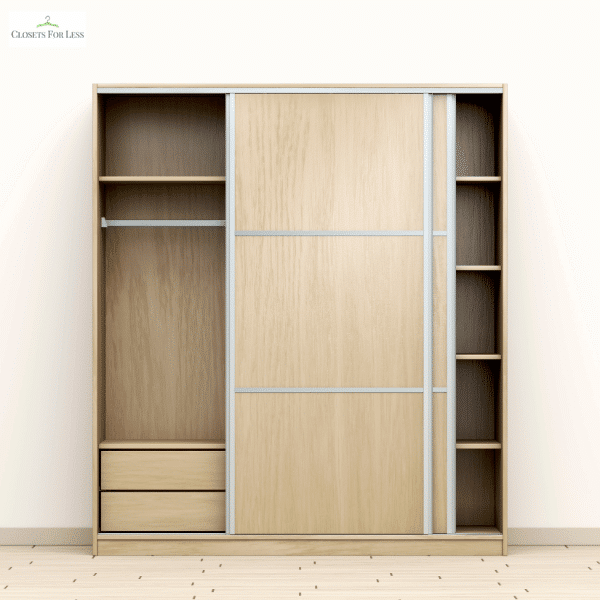
12. Sliding Door Closet to Save Space
In tight mudrooms, swinging doors can take up needed floor area. A sliding or barn-style closet door allows access to storage without blocking walkways. Combine interior hanging rods, shelves, and bins for a full-function setup behind the scenes. That smooth access adds clear benefits in narrow entries.
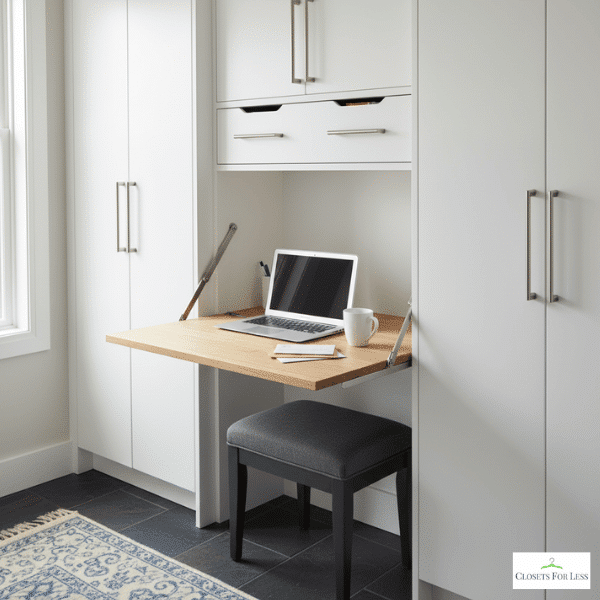
13. Drop-Down Desk in a Closet Niche
A drop-down surface within a small closet provides a flexible workspace without much depth. Use it for mail sorting, laptop use, or folding clean laundry. When you’re done, close it up for a clean mudroom view. Keep supplies in shallow drawers above or beside it.
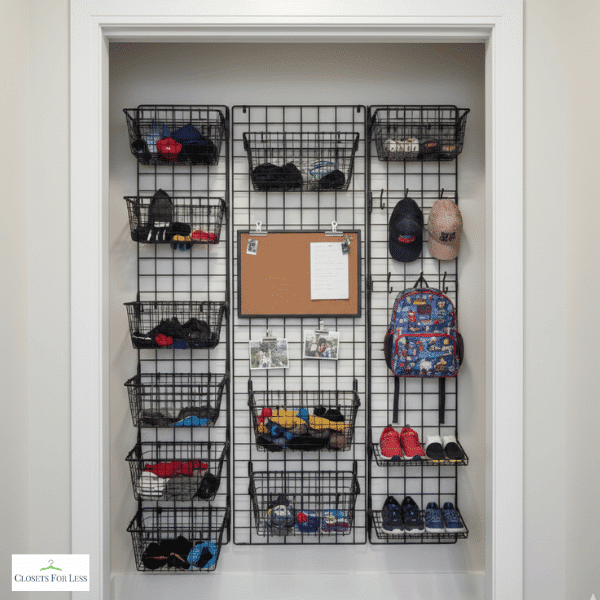
14. Wall Grid Storage System Inside a Closet
Install a wall-mounted metal or wood grid inside a deep closet and attach adjustable storage elements as needed. Mesh bins hold accessories, and hooks carry backpacks and hats. This modular approach works well for changing needs over time. It’s sturdy, compact, and efficient.
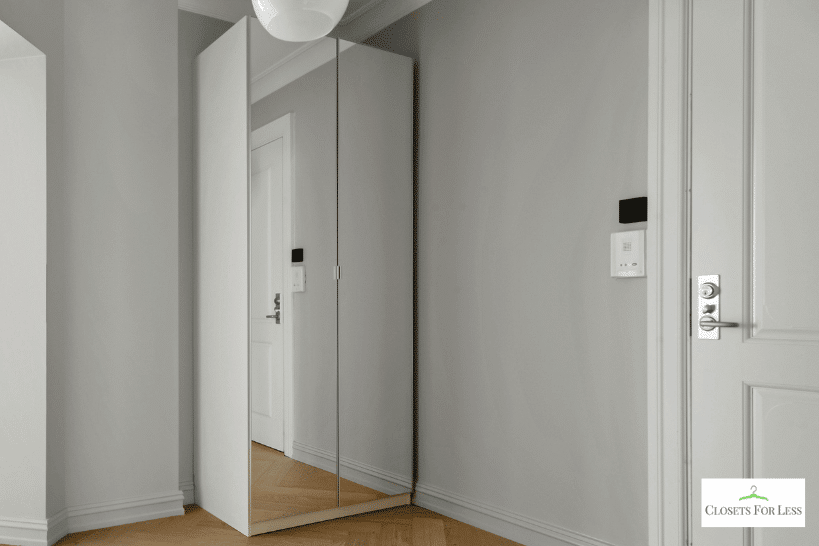
15. Full-Length Mirror on Closet Doors
Install mirrors on the front of your mudroom closet doors for a quick appearance check as you leave. They reflect light and help smaller spaces feel brighter. If you’re short on natural light near the front door, mirrors can indirectly help improve visibility too. Behind them, the closet keeps items tucked away.
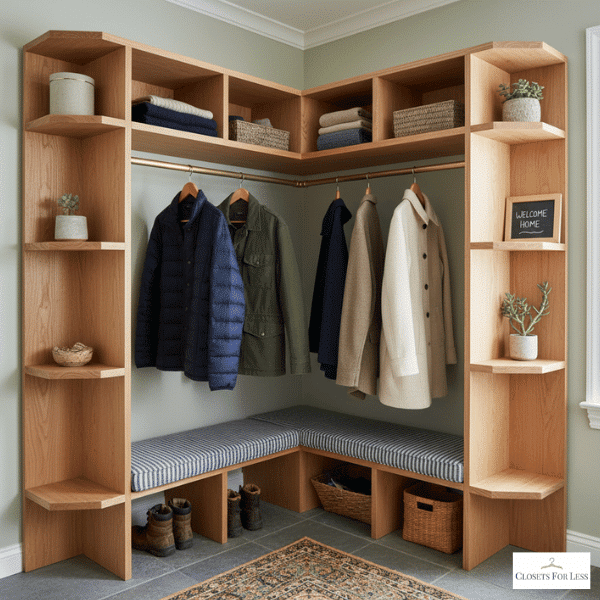
16. Angled Closet in Corner Conditions
Work with angled walls or unused corners to create triangular shelf units or cubicles. Fit custom rods along the longest wall and add wedges of shelving to the side. This setup creates usable storage space where traditional furniture can’t go. It’s a small but efficient fix for oddly shaped rooms.
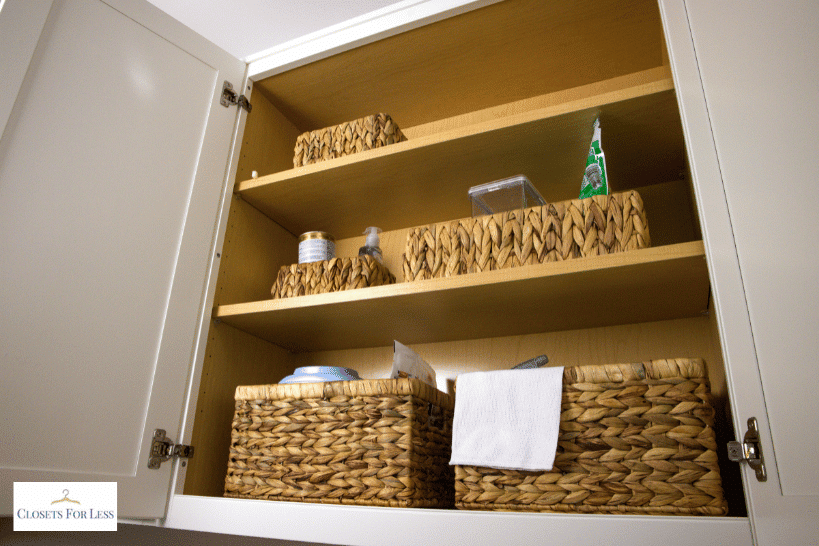
17. Mudroom Closet Turned Pet Station
Designate a pet gear section inside a larger mudroom closet. Use it for leashes, treats, supplies, and carriers. Add a small drawer insert or pull-out tray for food or cleanup bags. Keeping organized this way makes walks and feeding more efficient.
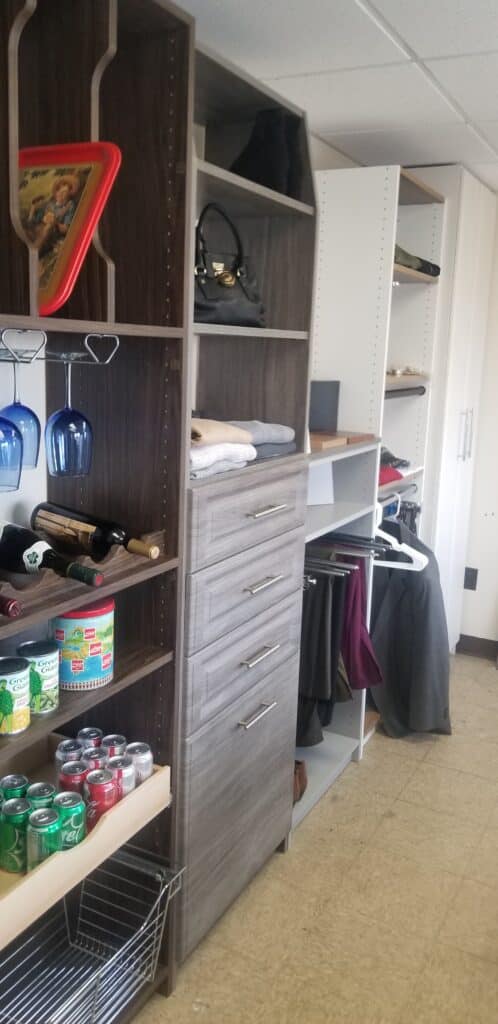
18. Multi-Level Locker Arrangement for Kids and Adults
A dual-height setup ensures both grown-ups and kids can reach what they need. Lower hooks, bins, or shelving help children stay independent. Upper cubbies serve adults for jackets and mail. It’s practical for shared spaces with differing height needs.
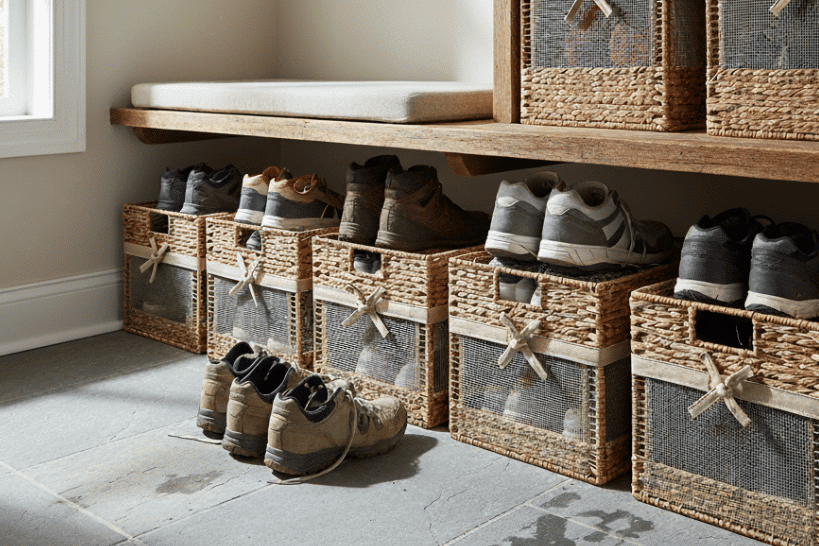
19. Mesh Front Baskets for Ventilated Shoe Storage
Storage baskets with mesh fronts improve airflow and help wet shoes dry faster. Stack them under benches or along closet walls in multiple rows. Mesh avoids mildew and keeps odors from building up. This is especially useful for seasonal boots or sports cleats.
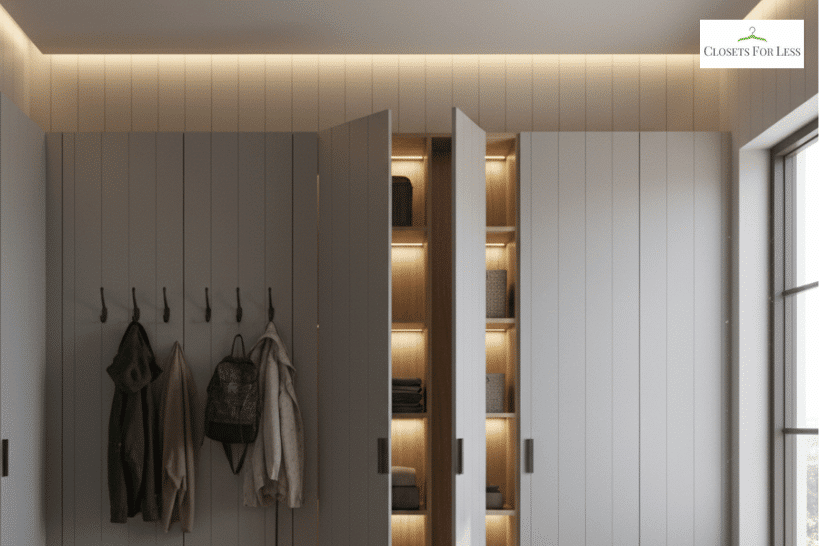
20. Pivot Lockers With Rotating Panels
Use pivoting panels within closet spaces to switch between front-facing and side-access gear. One side may have hooks, the other open shelves. It’s space-efficient and lets you hide clutter simply by turning the panel. Great for narrower mudrooms requiring more function per square foot.
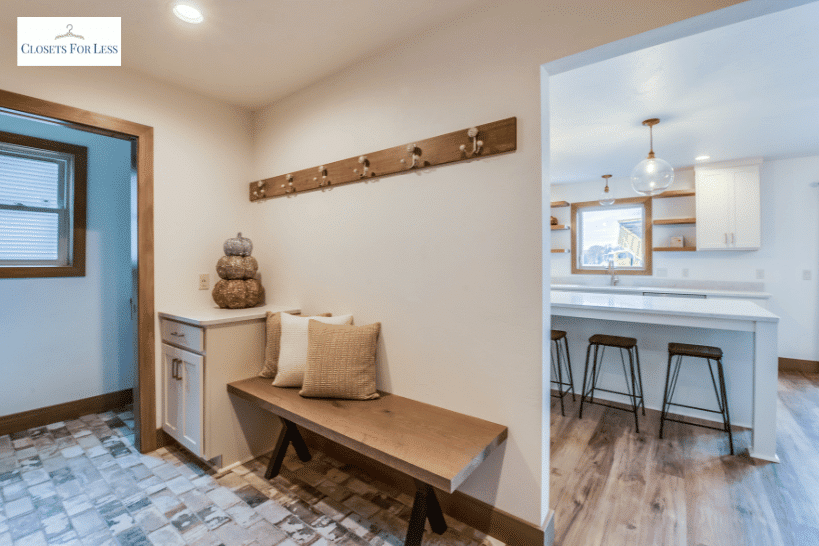
21. Mudroom Entry Between Garage and Kitchen
Set up your mudroom between the garage and kitchen area to create a practical pass-through. Use one side for closet space and the other for pantry or recycling bins. This layout contains a mess before it reaches the main living area. It’s also a good handoff point for groceries or gear.
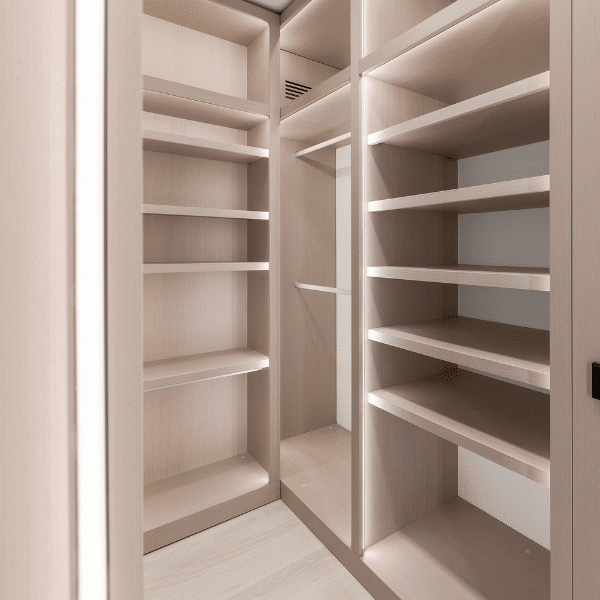
22. Smart Lighting Inside Each Closet Space
Good lighting is often overlooked in mudroom design. Built-in LED strips or motion lighting improves visibility inside cabinets and closets. This helps during early or late hours, especially near the garage door. Better lighting leads to better use of space.
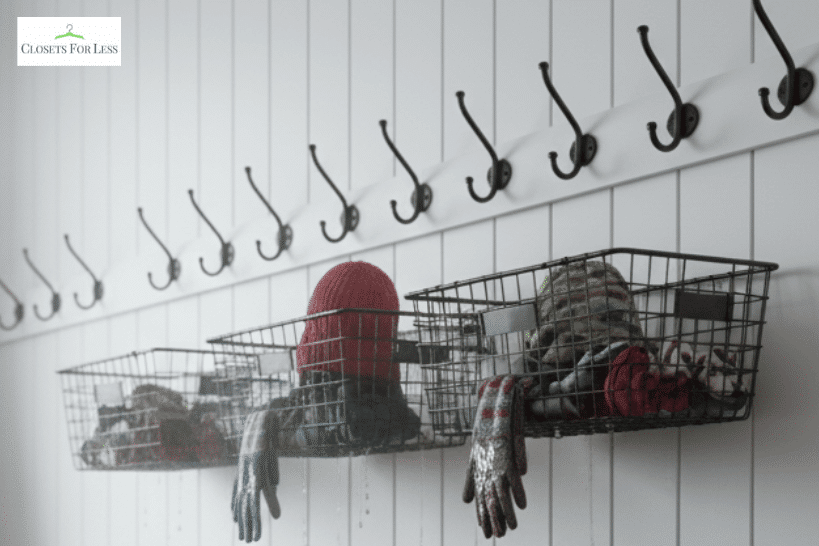
23. Hanging Basket System for Drying Damp Gear
Install wall hooks with hanging wire baskets to hold damp hats, gloves, and scarves. This keeps wet gear off the floor and separates it for drying. Use wire or mesh to allow air circulation. It’s useful in cold or rainy climates where wet accessories are frequent.
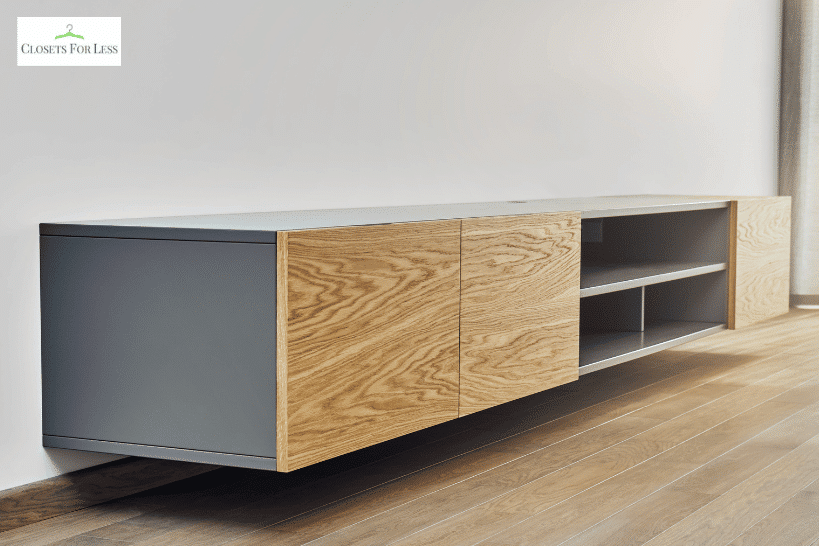
24. Floating Cabinets for Easy Floor Cleaning
Install floating cabinetry a few inches off the floor. The gap makes sweeping or vacuuming easier and keeps cabinetry dry in wet weather. These units often last longer and bring a clean, modern look to your mudroom design. You’ll appreciate the time saved on upkeep.
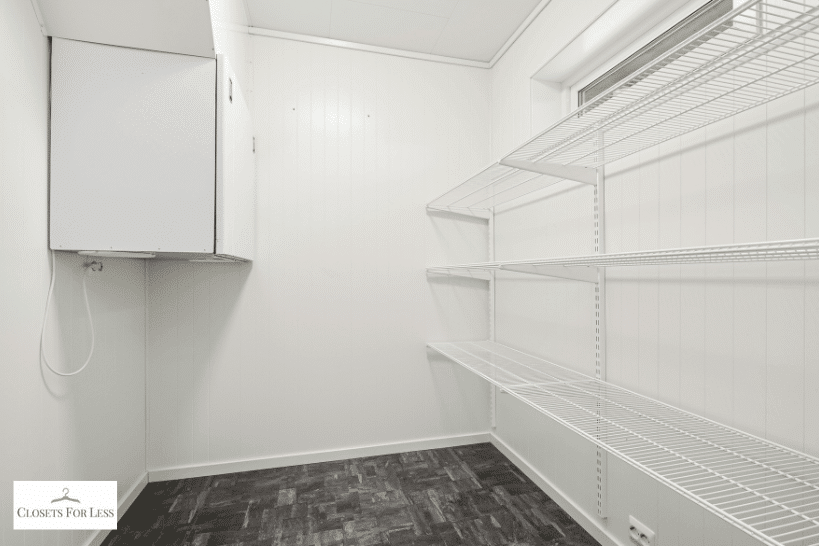
25. Expandable Closet System With Adjustable Components
Use an adjustable closet system that grows or changes with new household routines. Add or remove shelves, rods, or compartments over time. This modular approach fits evolving families without full renovation. It also allows precise control over what belongs where.
Why a Custom Mudroom Built Around Storage Just Works
A well-designed mudroom does more than hide your boots—it helps declutter your home by protecting the flow of everyday life. It protects the flow of the rest of the home by keeping entry areas clean, functional, and efficient. Closet space, when used right, manages seasonal gear, sports equipment, laundry room overflow, and daily mess so it doesn’t spread to common living areas.
A custom approach allows you to fit your home, your habits, and your routines—not the other way around. The result is storage space that works quietly in the background, doing its job without needing constant management.
Ready for More Order? Call the Mudroom Experts
Designing a custom mudroom takes more than a few hooks and baskets. It requires a layout that considers entry points, traffic flow, and the kind of storage systems your household will actually maintain.
That’s where Closets For Less can help.
We’ll work with you to figure out what belongs near your front door, how to build in long-term mudroom storage, and where closet space will give the most benefit. Call us to schedule a no-pressure consultation and start building a space that works for your day-to-day life—not just your Pinterest board.
Let Function Shape the Space
A custom mudroom doesn’t need flash. What matters is clarity—places for shoes, gear, and daily transitions that won’t disrupt the rest of the home. Whether you start with a tall closet, a small bench, or a woven basket under the stairs, every step toward order makes your space work better. Use these custom mudroom ideas to guide design that fits the flow of your household—and keeps the mess where it belongs.
If you’re planning your own mudroom build or remodel, start with what you carry and where you walk. The right storage system will do the rest.

